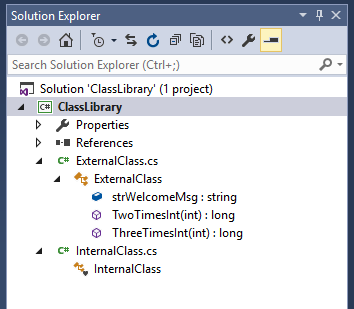- C# Class Library Projects Introduction
- C# Class Library Projects Part 2
In this post we provide the C# source code for a very simple example of a class library, as we continue from the previous post.
Here is where you can store all of your library routines. Our example only has three objects: a welcome string, a time two method, and a times three method. For a client application to use these they must be public. Also, static objects do not need to be instantiated by the calling application.
using System;
using System.Collections.Generic;
using System.Linq;
using System.Text;
using System.Threading.Tasks;
using static System.Console;
namespace ClassLibrary
{
public class ExternalClass
{
public string strWelcomeMsg = "Welcome!";
public long TwoTimesInt(int intMyInteger)
{
return (2 * intMyInteger);
}
public static long ThreeTimesInt(int intMyInteger)
{ // static does not need to be instantiated.
return (3 * intMyInteger);
}
}
}
Here is what the Solution Explorer looks like. There is an internal class but there is no code in it.

using System;
using System.Collections.Generic;
using System.Linq;
using System.Text;
using System.Threading.Tasks;
using static System.Console;
using ClassLibrary; // this is my class
namespace ClientApp
{
class Program
{
static void Main(string[] args)
{
// This app makes use of my C# ClassLibrary
// I needed to add a reference to my library
// Optionally I can add a using statement as shown above.
long longResult;
longResult = ExternalClass.ThreeTimesInt(3);
WriteLine(longResult);
ClassLibrary.ExternalClass myObj = new ClassLibrary.ExternalClass();
longResult = myObj.TwoTimesInt(3);
WriteLine(longResult);
WriteLine(myObj.strWelcomeMsg);
ReadKey();
}
}
}
Here is a view of the Solution Explorer for the client application.

Here is a view of the Object Browser for the client application.

Making use of external classes in external assemblies is necessary in C# programming and is something you do all the time when you use any of the classes in the .NET Framework.